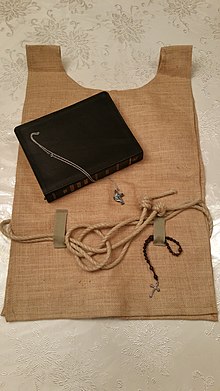 A hairshirt belonging to a Christian, with a set of prayer beads hanging off a belt loop used to hold the girdle that tightens the garment around the waist | |
| Type | Undergarment |
|---|---|
| Material | Coarse cloth or animal hair |
| Place of origin | Cilicia |
| Introduced | Post-Exilic period |

A cilice /ˈsɪlɪs/, also known as a sackcloth,[1] was originally a garment or undergarment made of coarse cloth or animal hair (a hairshirt) worn close to the skin. It is used by members of various Christian traditions (including the Catholic,[2] Lutheran,[3] Anglican,[4] Methodist,[5] and Scottish Presbyterian churches)[6] as a self-imposed means of repentance and mortification of the flesh; as an instrument of penance, it is often worn during the Christian penitential season of Lent, especially on Ash Wednesday, Good Friday, and other Fridays of the Lenten season.[7]
Hairshirt cilices were originally made from coarse animal hair, as an imitation of the garment worn by John the Baptist that was made of camel hair,[8] or sackcloth which, throughout the Bible, was worn by people repenting.[9] Cilices were designed to irritate the skin; other features were added to make cilices more uncomfortable, such as thin wires or twigs. In modern Christian religious circles, cilices are simply any device worn for the same purposes, often taking the form of a hairshirt cilice as well as a (spiked metal) chain cilice.[10]
- ^ Jeffrey, David L. (1992). A Dictionary of Biblical Tradition in English Literature. Wm. B. Eerdmans Publishing. p. 673. ISBN 9780802836342.
- ^ Stravinskas, Peter M. J.; Shaw, Russell B. (1998). Our Sunday Visitor's Catholic Encyclopedia. Our Sunday Visitor Publishing. p. 483. ISBN 9780879736699.
- ^ Neve, Juergen Ludwig (1914). The Augsburg Confession: A Brief Review of Its History and an Interpretation of Its Doctrinal Articles, with Introductory Discussions on Confessional Questions. Lutheran Publication Society. p. 150.
- ^ Knight, Mark; Mason, Emma (16 November 2006). Nineteenth-Century Religion and Literature: An Introduction. Oxford University Press. p. 96. ISBN 9780191535017.
Pusey regularly endured a hair shirt as well as self- imposed flagellation and fasting routines.
- ^ Bergen, Jeremy M. (31 March 2011). Ecclesial Repentance: The Churches Confront Their Sinful Pasts. A&C Black. p. 255. ISBN 9780567523686.
In fact, it was scandal of disunity within Methodism that led UMC leaders to address the issue of racism as the underlying cause. ... The petition for forgiveness proceeded on two distinct but interrelated levels. Each of the approximately 3,000 persons in the assemble was called to silent personal confession of the sin of racism before God, publicly symbolized by receiving ... sackcloth ... and the imposition of ashes.
- ^ Yates, Nigel (11 June 2014). Eighteenth Century Britain: Religion and Politics 1714-1815. Routledge. p. 87. ISBN 9781317866480.
The Evangelical revival in Scotland encouraged both much stricter conditions being placed on admission to Holy Communion and the maintenance of traditional discipline within the established church. ... Lesser transgressors could be ordered by the kirk session to stand before the congregation for up to three Sundays, sometimes wearing sackcloth, and publicly acknowledge their sins before 'being subjected to a "rant" from the minister'.
- ^ Beaulieu, Geoffrey of; Chartres, William of (29 November 2013). The Sanctity of Louis IX: Early Lives of Saint Louis by Geoffrey of Beaulieu and William of Chartres. Cornell University Press. p. 89. ISBN 9780801469145.
- ^ Brewer, Ebenezer Cobham (1884). A Dictionary of Miracles: Imitative, Realistic, and Dogmatic. Chatto and Windus. p. 56.
- ^ CSB Study Bible. B&H Publishing Group. 15 June 2017. p. 1404. ISBN 978-1-4336-4811-3.
Sackcloth was worn during times of mourning and repentance, usually while sitting atop ashes (Gn 37:34; 1Kg 21:27; Mt 11:21).
- ^ Morrow, Jeffrey L. (13 October 2020). Liturgy and Sacrament, Mystagogy and Martyrdom: Essays in Theological Exegesis. Wipf and Stock Publishers. ISBN 978-1-5326-9382-3.